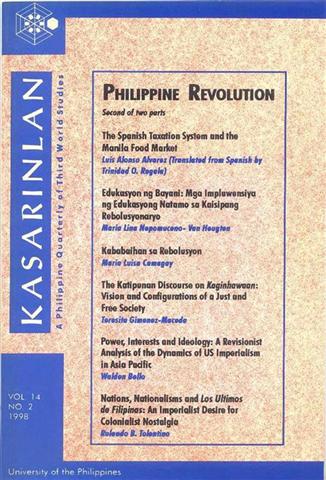Edukasyon ng Bayani: Mga Impluwensya ng Edukasyong Natamo sa Kaisipang Rebolusyonaryo
Abstract
The most important moment in the history of the republic was guided, perhaps predictably, by members of an educated class. The exceptions were likewise of exceptional intelligence. They were all learned, learned enough to understand that it is not in the Filipino people’s best interest to remain under Spanish rule. The author raises valid points. All the architects of the revolution were once students. Where were they educated? How well did they do in school? Did the prevailing educational system send them on the path to rid the colony of its master of three centuries?The state of Philippine colonial education was described as backward and restrictive particularly to those who believe that the only relevant educational arrived with the American flag. The more affluent families sent their sons to the elite private schools, Ateneo Municipal, Colegio de San Jose and Colegio San Juan de Letran, and the premiere university, the Royal and Pontifical University of Santo Tomas. The first two were under the Jesuit order while the latter were controlled by the
Dominicans.
The key players of the revolution namely Jose Rizal, Marcelo del Pilar, Emilio Jacinto and Apolinario Mabini all attended the University though their paths and their performance varied. Rizal, who would later be executed for his alleged involvement in the revolution, was of an elite background and was no stranger to the rigors of learning even at an early age. In Ateneo, Rizal performed with excellence, but was only as excellent as most of his classmates. He began his studies at the University with an unprecedented completion of his pre-medical and first year medical studies during his first year. Marcelo del Pilar spent six mediocre years at Colegio San Juan de Letran in preparation for the University’s seven-year law course which he completed in ten with renewed interest and consequently better ratings. Emilio Jacinto, who will later become one of the leaders of the Katipunan, was dirt poor but was remarkably comfortable with the Spanish language. The outbreak of the revolution kept him from pursuing law. Apolinario Mabini, one of the architects of the revolution, attended Letran, but had to stop schooling after the fourth year when he could no longer support himself. He taught for two years before finishing, however, Mabini could not get his degree until a year later despite excellent performance due to the inability to pay the examination fee. The law degree soon followed at the University where he surpassed Rizal in terms of sobresalientes. Bonifacio, who defined the revolution as that of the masses, was said to have reached the equivalent of the fourth grade. What was not able to accomplish by attending school he perfected by reading a library’s worth on many fields of inquiry, including philosophy and the French revolution. Aguinaldo, the man who would be president of the republic attended both Letran and UST but was not able to complete the secondary level. Convinced he had learned enough from the schools and his tutors, Aguinaldo returned to Cavite to undergo further tutoring. In Cavite, he became a cabeza de barangay, a post bought by his mother to save him from forced labor. Aguinaldo was said to have preferred watching docked and docking ships to academics. Though one of the few who were able to secure a copy of Noli Me Tangere, Aguinaldo was not able to appreciate Rizalís insights due to his limited understanding of the Spanish language. In the end it was clear that most of them shared a similar opinion on the need for change and worked towards it the it the best way they know how.
Tomism rejected the acquisition and expansion of thinking, imposing restrictions of scientific inquiry. This way, the University became Spainís downfall The stranglehold on the pursuit of knowledge imposed by the religious order could only have directed the these men and their consciousness elsewhere. The French Revolution was not yet a distant memory and easily seized their imagination. Bishop Juan Aragones response to the then Governor-General Izquierdo proposal to impose stricter standards on those who wish to enter the seminary proved prophetic. The most dangerous men in the colony were educated.
Published
2009-07-24
Section
Features
By submitting a manuscript, the authors agree that the exclusive rights to reproduce and distribute the article have been given to the Third World Studies Center.



